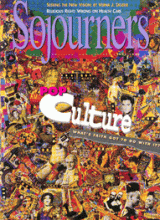God created and saw that it was good. But since then things have been more ambiguous. Good and evil, clean and unclean, truth and lies, blessing and curse, prophets and false prophets: We are left to sort out this material world with a prayer, a promise of the Spirit's guidance, and a tradition shaped by people who were perhaps just as confused as we are.
Are cultural expressions only holy if the Word is spelled out in big block letters? Or is the Word, present at the creation of all that is, whispering and shouting in all subsequent acts of creation, needing no alphabet or subtitles?
In the name of God, our God, in the name of Christ, our Christ: Christians have gilded cathedrals, sent buttresses flying, frescoed and sculpted and painted and stained glass. And they have built churches with walls as square and plain as dogma, with clear windows, the better to see God, undistracted by beauty. Or they have designed sturdy, graceful furniture, raised barns, and molded tools that were odes to a practical God (form meets function in a sort of ecstatic prayer).
Christians have refused to sing hymns and burned rock-and-roll records because they were too worldly. They have composed symphonies and oratories and sweet gospel ballads and praise-Jesus thrash metal and defiant spirituals. They have composed poetry, written novels, produced morality plays, and burned books.
To be Christian and to be an artist is to stand in ambiguitycalled to create, but not to make idols of our creations. To love God is to love the world but not be defined by it. But, as Annie Dillard writes, "What can any artist set on fire but his or her world?...What can an artist use but materials, such as they are?" There is no hard and fast rule for the point at which an artist ceases to mold materials and becomes molded by them. This is as true for popular culture as it is for the classical arts.
Read the Full Article

